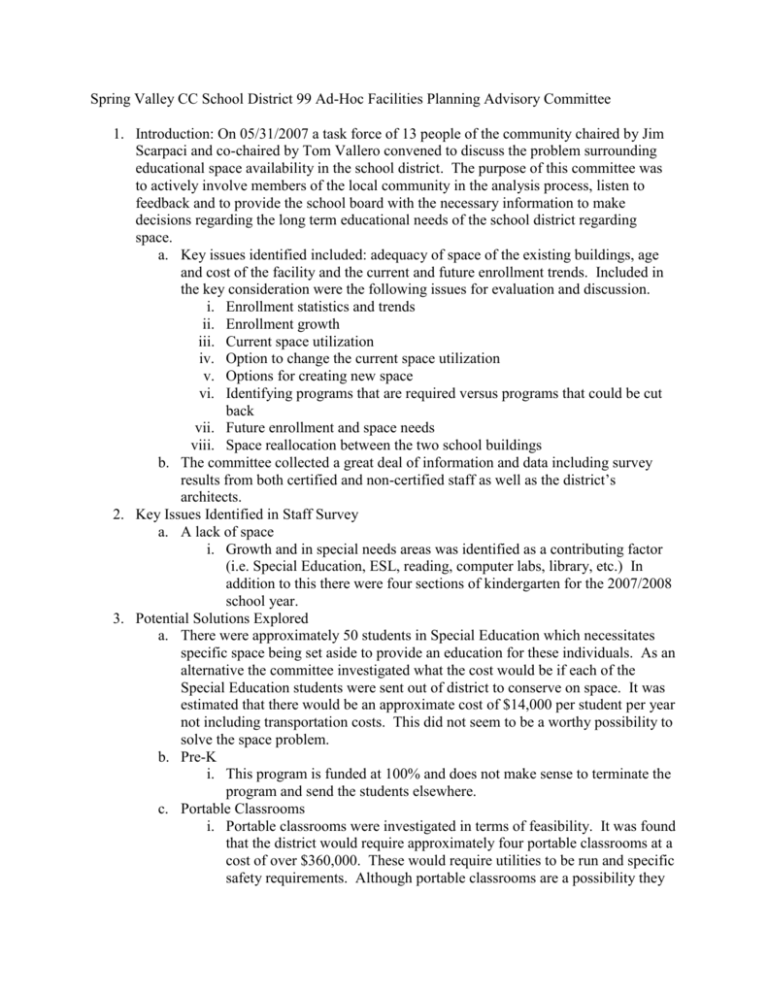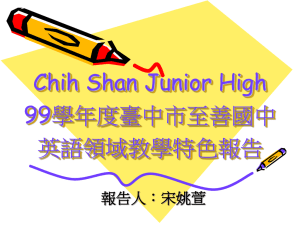Spring Valley CC School District 99 Ad
advertisement

Spring Valley CC School District 99 Ad-Hoc Facilities Planning Advisory Committee 1. Introduction: On 05/31/2007 a task force of 13 people of the community chaired by Jim Scarpaci and co-chaired by Tom Vallero convened to discuss the problem surrounding educational space availability in the school district. The purpose of this committee was to actively involve members of the local community in the analysis process, listen to feedback and to provide the school board with the necessary information to make decisions regarding the long term educational needs of the school district regarding space. a. Key issues identified included: adequacy of space of the existing buildings, age and cost of the facility and the current and future enrollment trends. Included in the key consideration were the following issues for evaluation and discussion. i. Enrollment statistics and trends ii. Enrollment growth iii. Current space utilization iv. Option to change the current space utilization v. Options for creating new space vi. Identifying programs that are required versus programs that could be cut back vii. Future enrollment and space needs viii. Space reallocation between the two school buildings b. The committee collected a great deal of information and data including survey results from both certified and non-certified staff as well as the district’s architects. 2. Key Issues Identified in Staff Survey a. A lack of space i. Growth and in special needs areas was identified as a contributing factor (i.e. Special Education, ESL, reading, computer labs, library, etc.) In addition to this there were four sections of kindergarten for the 2007/2008 school year. 3. Potential Solutions Explored a. There were approximately 50 students in Special Education which necessitates specific space being set aside to provide an education for these individuals. As an alternative the committee investigated what the cost would be if each of the Special Education students were sent out of district to conserve on space. It was estimated that there would be an approximate cost of $14,000 per student per year not including transportation costs. This did not seem to be a worthy possibility to solve the space problem. b. Pre-K i. This program is funded at 100% and does not make sense to terminate the program and send the students elsewhere. c. Portable Classrooms i. Portable classrooms were investigated in terms of feasibility. It was found that the district would require approximately four portable classrooms at a cost of over $360,000. These would require utilities to be run and specific safety requirements. Although portable classrooms are a possibility they are only a temporary solution to a growing problem with enrollment statistics and student mobility. 4. Committee Findings a. In conjunction with the 2000 referendum the district applied for a state grant that was approved. We still hold that placement on the waiting list. b. The information from the grant needs to be updated with current information. c. Mr. VanDusen thought we would still be in the 75% funding level. d. We qualified for the grant on the basis that a large percentage of the SVES students are inadequately housed while at school. e. The plan called for the existing JFK to house pre-K through 5th grade. The new addition would be for junior high. f. The 1999 plan called for a 46,100 square foot addition and with a cost of just under $5,875,000. g. Cost per square foot for the old plan was $90. The cost now would be approximately $140 per square foot plus about a 40% increase in all other costs. h. Lincoln is land locked with no possibility to add on. The building has minimal work and would probably cost more to tear down and haul away than what the property could be sold for. i. Portable classrooms can be purchased new or rented. This is a temporary solution. j. Utilities must be extended to the portable classrooms. k. The new portable classroom cost is approximately $97 per square foot for two rooms which includes a male and female restroom. Purchase price is approximately $170,000 - $180,000. l. Portable classrooms can be rented at approximately $14 - $15 per square foot plus the cost of utilities, however this is only a temporary solution based on the enrollment trend. m. Cost to construct per classroom is approximately $100,000. n. Some accommodations and modifications can be made with space utilization for one to two more years before there would be absolutely no other alternatives than putting students in hallways. o. Our school district can issue bonds for $6,000,000. p. Health/Life Safety bonding costs exceeds new construction costs. q. The next Life Safety survey is scheduled for six years. r. The estimated cost from the last survey to make Lincoln up to code was $40,000 not including the boiler. s. The 1999 plan calls for 17 classrooms plus an office. Lincoln has 11 classrooms now. 5. Executive Summary a. The committee has analyzed a significant amount of information and data which has lead it’s members to conclude that the current space between both school buildings is not adequate to meet the districts future needs. In addition any modifications done to Lincoln school would be putting money into a building that eventually will not meet code anymore. In addition the committee has found that eliminating programs or tuitioning special education students out of the district are not a viable option because it is disruptive to educational process and is cost prohibitive. Portable classrooms is an option for both rental and purchase as a temporary solution. The Committee’s final recommendations are for the Board to consider a referendum. To construct additional space that would be added onto JFK or for a new building that would be built on the district’s existing ten acres. Portable classrooms should be evaluated as a short term solution.








